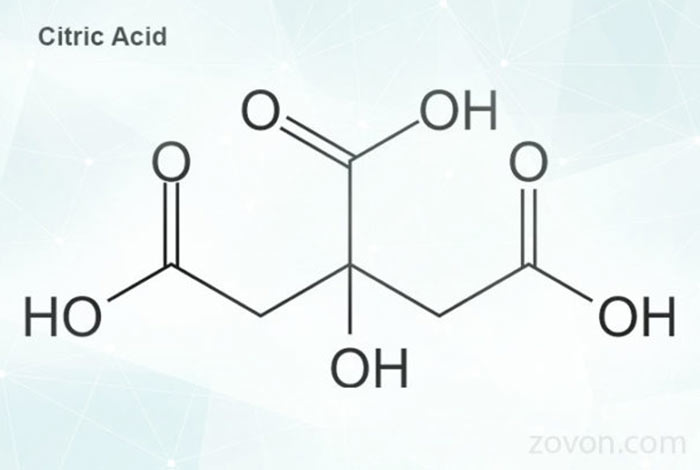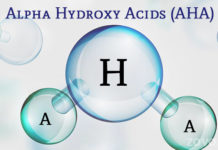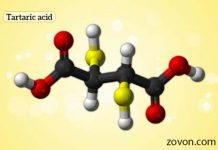
Citric Acid Sources, Benefits, Side Effects & FAQs

Biochemically citric acid is an organic acid, either naturally occurring or chemically synthesized compound and it belongs to AHA (Alpha Hydroxy Acid) family. Naturally, citric acid is found in fruits and vegetables those taste sour. Organic synthesized citric acid is used for food flavoring and preservation.
It is different from Vitamin C (ascorbic acid). Synthesized citric acid is a water-soluble molecule whose solubility increases with rising water temperature. It is also soluble in ethanol, benzene, chloroform.
Structure of Citric Acid:
Citric acid is an intermediate of the Tricarboxylic Acid (TCA) cycle or Krebs cycle. It can either be anhydrous or monohydrate state. The anhydrous form is crystallized from hot water, whereas, the monohydrate form is crystallized from cold water. Its IUPAC name is 2-Hydroxypropane-1,2,3-tricarboxylic acid. Its chemical composition is C6H8O7.
The structure is illustrated below:

Sources of Citric Acid:
It can either be naturally occurring or synthesized chemically.
Natural citric acid:
- Naturally, it is found in a lot of common fruits such as oranges, limes, lemons, grapes etc. lemons and limes contain the highest amount of citric acid.
- Berries such as cranberry, strawberry, raspberry, gooseberries, cherries, blackcurrant, redcurrant etc. contain citric acid.
- Tamarind and pineapples are other fruits those contain natural citric acid.
- Among vegetables, lettuce, spinach, and tomatoes are the natural sources.
Synthesized citric acid:
- Synthesized citric acid is solid crystalline and colorless. It is highly used in beverages.
- Synthesized citric acid can be found in soft drinks, jam, jelly, ice-creams, sauces, mayonnaise, cheese spread, canned fruits, and vegetables.
- Wine and sourdough bread also contain synthesized citric acid.
Benefits of Citric Acid:
It has a huge natural resource in fruits and vegetables and beneficial for health. At the same time, chemical synthesis of citric acid is cost effective and has a large market as a beverage ingredient. It has several effects on human skin, kidney, and metabolic system and reduces fat as well. The synthesized citric acid also has a number of industrial applications. Some important application of natural and synthetic citric acid is listed below:
Some important application of natural and synthetic citric acid is listed below:
- It helps to kill bacteria and virus.
- It converts carbohydrates into carbon dioxide (CO2) that increases metabolism and supplies energy faster.
- It prevents kidney stones. It makes urine unfavorable for stone forming. It inhibits problems caused by the small stones and sometimes prevents their enlargement
- Highly used in preserving food and beverages. It adds a sour flavor to foods.
- It is used for medical purposes such as ingestion, personal care.
- It is a good cleaning agent against grease; used for cleaning bathroom and kitchen.
- Citric acid is a fine chelating agent that bound ions of molecules and strengthen the metal.
- It inhibits corrosion of stainless steel.
- Used in developing the photographic film.
- It is used to create an acidic environment to catalyze the ripening mechanism while preparing cheese and mozzarella.
Some More Important Facts about Citric Acid
- Citric acids are an alkalizing agent that makes the urine less acidic and reduces the chance of kidney stone.
- It is harmful to patients who are suffering from kidney failure.
- Heart patients should stay away from this element.
- Citric acid is not a nutrient for the ones who have an excess level of potassium in their blood.
- This keeps urinary tract clean and prevents infection.
- It could be a toxic element during pregnancy.
Side-effects of Citric Acid:
Excess supply of citric acid in the human body could be harmful in several ways mentioned below:
- The most common symptom caused by citric acid surplus is stomach cramps or pain.
- Diarrhea, nausea, vomiting, loss of appetite are some health problems caused by the overdose of citric acid.
- Coughing up in blood, slow breathing, irregular heartbeat are severe physiological problems one could experience due to the overdose of citric acid.
- Restlessness, muscle pain, swelling, tingling in hands and feet.
- Black, bloody stools, convulsions
- Nervousness, irritation, mood swings
FAQs: What people normally want to know about Citric Acid?
1. Is citric acid safe for skin?
citric acid is safe in proper concentration in skin care or beauty care products. This could brighten dull skin. Excess concentration of citric acid in daily used skin care products may cause skin irritation, dryness, itching etc. It can be extracted from corm for industrial use. If anyone has the corn sensitivity, must check the source of the product carefully.
2. What are the differences between citric acid and vitamin C?
Although both of them are organic acids yet actually different chemically. Vitamin C is ascorbic acid and not at all citric acid. Citrus fruits are the warehouse of both citric acid and ascorbic acid but compositionally citric acid contains one extra oxygen atom than ascorbic acid. It’s an excellent food additive for its sour taste, whereas, ascorbic acid is a better food preservative. It produced synthetically in a large number for its varied uses in foods and beverages. Ascorbic acid is strictly natural and available in fruits, vegetables, milk etc.
3. Does citric acid reduce weight?
Citrus fruits are helpful for their antioxidant and fa burning properties. It helps in increasing metabolism too that reduces fat. Although there’s no direct correlation between consumption of citric acid and reducing fat, yet they are helpful and healthy too. Result says lemon in warm water with one spoon honey in empty stomach is a home remedy against fat. It too improves digestion system.
4. Which fruits are the best source of citric acid?
Limes and lemons are the best sources of citric acid. Others include green apple, grapefruits, berries, grapes, oranges. Green vegetables such as spinach, lettuce, parsley are sources of citric acid. Other than natural sources, jam, jelly, cheese are some other chemical sources of citric acid.
5. What bacteria produces citric acid?
It is produced by submerged fermentation using Aspergillus niger and Candida sp. From different sources of carbohydrates like starch and molasses.
6. Is citric acid all natural?
It is available in the citrus-fruits and green vegetables are natural. But for its extensive and versatile usage, it also chemically produced in a large amount. It is also synthesized by bacteria through the submerged fermentation process.










